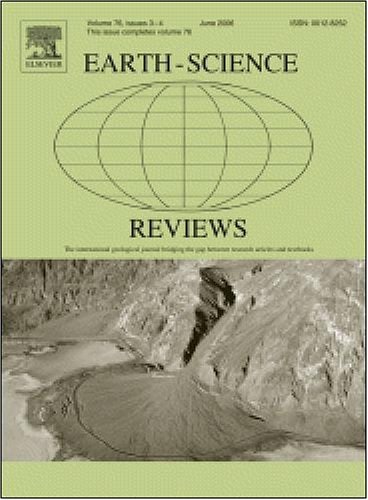Quartz types, formation mechanism, and its effect on shale oil and gas enrichment: A review
IF 10.8
1区 地球科学
Q1 GEOSCIENCES, MULTIDISCIPLINARY
引用次数: 0
Abstract
Quartz is one of the most common minerals in the Earth's crust, and its deposition and cycling are ubiquitous and crucial in energy and environmental sciences. Due to the existence of multiple types of quartz and diverse mechanisms that result in their formation, this variation is expected to significantly impact shale deposition, diagenesis, and reservoir properties. Moreover, it plays a crucial role in the enrichment, development, and production of shale oil and gas plays. Considering their importance, this study systematically summarizes observation and various research methods, such as optical and scanning electron microscopy (SEM), cathodoluminescence (CL), energy dispersive spectrometry (EDS), X-ray fluorescence (XRF), quantitative evaluation of minerals by scanning electron microscopy (QEMSCAN), fluid inclusion, which supports our understanding of the mineral diagenesis and generation of both detrital and authigenic origins. Parent rock type, transport distance, and depositional environment are known factors that control the grain size, sorting, roundness and types of detrital quartz. The authigenic quartz contains biogenic, hydrothermal origins and clay mineral transformation while fluid source, diagenetic mechanisms, and growth space control the formation time and crystal size of them. In addition, quartz controls the total organic carbon content, reservoir quality, fracturing ability, organic matter preservation and reservoir enrichment, etc. Notably, the microquartz cement derived from biosiliceous allochems (namely biogenic quartz) has a noticeable positive correlation with total organic carbon content and is formed during the early diagenetic stages which together with the detrital quartz form a rigid framework favorable to primary pores, ultimately forming high-quality marine shale reservoirs. Furthermore, the diagenesis of biogenic quartz also enhances the mechanical properties and fracturing potential of shale reservoirs. The biogenic quartz content and the thickness of shale intervals determine the potential and development of marine shale oil/gas reservoirs. However, in transitional and lacustrine shales, quartz is predominantly detrital in origin and negatively correlated with organic carbon content. In these two types of shales, detrital quartz and quartz formed during the transformation of clay minerals are known to play a positive role in the formation of shale reservoirs and hydrocarbon enrichment. Considering all of these factors, this study investigates different types and contents of quartz in typical shale oil and gas reservoirs worldwide and explains how they have influenced shale oil and gas enrichment and reservoir productivity.
石英类型、形成机制及其对页岩油气富集的影响
石英是地壳中最常见的矿物之一,它的沉积和循环无处不在,在能源和环境科学中至关重要。由于石英存在多种类型,其形成机制也多种多样,因此这种变化有望对页岩沉积、成岩作用和储层性质产生重大影响。此外,它在页岩油气的富集、开发和生产中起着至关重要的作用。鉴于其重要性,本研究系统总结了观察和各种研究方法,如光学和扫描电镜(SEM)、阴极发光(CL)、能量色散光谱(EDS)、x射线荧光(XRF)、扫描电镜(QEMSCAN)矿物定量评价、流体包裹体等,以支持我们对碎屑和自生成因的矿物成岩作用和成因的认识。母岩类型、搬运距离和沉积环境是控制碎屑石英粒度、分选、圆度和类型的已知因素。自生石英包括生物成因、热液成因和粘土矿物转化,流体来源、成岩机制和生长空间控制了其形成时间和晶体大小。此外,石英还控制着总有机碳含量、储层质量、压裂能力、有机质保存和储层富集等。值得注意的是,来自生物硅质异化学(即生物成因石英)的微石英胶结物与总有机碳含量呈显著正相关,形成于早成岩阶段,与碎屑石英形成有利于原生孔隙形成的刚性格架,最终形成优质海相页岩储层。此外,生物成因石英的成岩作用也提高了页岩储层的力学性质和压裂潜力。生物成因石英含量和页岩层厚度决定了海相页岩油气藏的潜力和开发程度。而在过渡型和湖相页岩中,石英以碎屑岩为主,与有机碳含量呈负相关。在这两种类型的页岩中,碎屑石英和粘土矿物转化过程中形成的石英对页岩储层的形成和油气富集起着积极的作用。综合上述因素,研究了全球典型页岩油气储层中石英的不同类型和含量,并解释了石英对页岩油气富集和储层产能的影响。
本文章由计算机程序翻译,如有差异,请以英文原文为准。
求助全文
约1分钟内获得全文
求助全文
来源期刊

Earth-Science Reviews
地学-地球科学综合
CiteScore
21.70
自引率
5.80%
发文量
294
审稿时长
15.1 weeks
期刊介绍:
Covering a much wider field than the usual specialist journals, Earth Science Reviews publishes review articles dealing with all aspects of Earth Sciences, and is an important vehicle for allowing readers to see their particular interest related to the Earth Sciences as a whole.
 求助内容:
求助内容: 应助结果提醒方式:
应助结果提醒方式:


